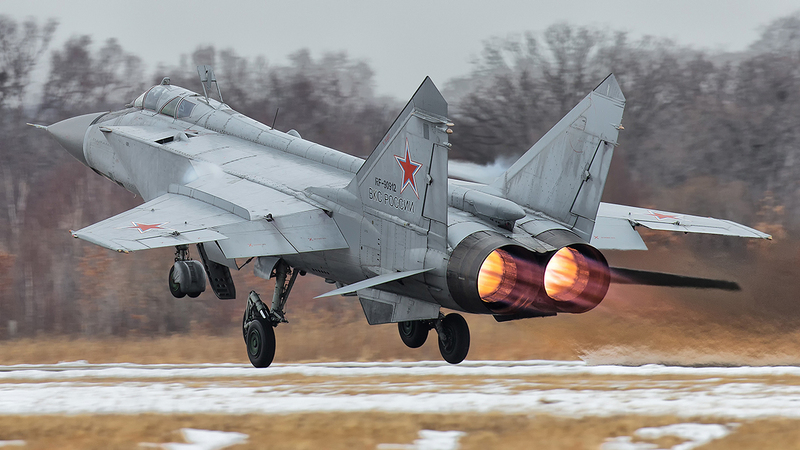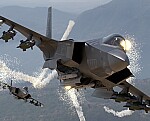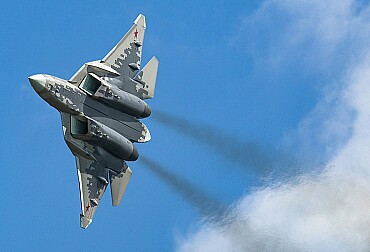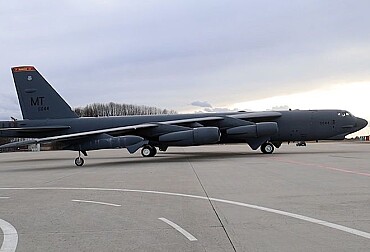The MiG 31 Foxhound – the world's fastest fighter jet
The MiG-31M represents the pinnacle of military aviation development in the USSR, which is why a certain amount of information about it is still confidential. It has been established that the MiG-31M outperforms all the aircraft in the world in its class by almost 500km/h in terms of maximum speed. Each MiG-31 can operate both autonomously and as an air command centre, directing the work of other interceptors, attached fighters and ground-based air defence assets. The power of the onboard computer and communication equipment is sufficient for this purpose. Once in service, the MiG-31 considerably reduced the frequency of flights by American spy planes.

From MiG-25 to MiG-31
The appearance of the MiG-25 Foxbat had surprised and worried the West, until the defection of one of these aircraft to Japan on 6 September 1976 made them discover the aircraft's limitations. Apart from the usual faults associated with production in Soviet factories such as the poor quality control, finish below Western standards, etc., NATO analysts realised that the MiG-25 had been designed for speed, and that everything had been sacrificed in the quest for speed.
The Foxbat was incapable of taking part in circling combat and was difficult to fly at low altitude. Worse still, its super-powerful engines were so fragile that at maximum speed, they deteriorated rapidly, requiring frequent engine changes. Finally, their fuel consumption was such that the MiG-25's range at supersonic speed was very limited.
In 1975, the Soviets began work on an improved version of the Foxbat, based on the same airframe. This new variant was intended to replace the MiG-25 in interception missions, as well as the old Tupolev Tu-128. On 16 September 1975, a demonstrator, the Ye-155MP, made its maiden flight. The engineers at OKB Mikoyan increased the proportion of titanium and aluminium in the structure of the new aircraft, changed the engine, increased the amount of fuel on board and made it possible to exceed Mach 1 at low altitude.
Western reconnaissance satellites soon detected the prototype at the Ramenskoye flight test centre near Moscow, where they made frequent visits in search of new Soviet equipment. After this discovery, the mysterious aircraft returned to obscurity: it wasn't until 1985 that a Norwegian pilot took a photograph of it in flight, and the Paris Air Show in 1991 that it was presented to the public. In the meantime, the Soviets carried out numerous tests, using around ten prototypes and pre-production aircraft, before launching production in 1979. It was named the MiG-31, while NATO called it the Foxhound.
Mikoyan-Gurevich MiG-31 Foxhound
The MiG-31 is very similar to the MiG-25, except that it carries a second crew member, who is in charge of weapons and on-board systems. However, its wings and air intakes have been enlarged, making it easier to fly at low altitude, but still severely limiting the aircraft's possibilities in rotary combat. However, this posed no problem for the Soviets, as the aircraft was not designed for this type of mission.
Its two D-30-F6 engines are theoretically capable of propelling it to Mach 3, although in reality Mach 2.83 is the true maximum speed. Large fuel tanks give it a long range: at Mach 2.35, a MiG-31 has a range of almost 720 kilometres. The Soviets determined that four aircraft could cover a patrol area of 800 by 900 kilometres, which was and still is perfectly suited to protecting Russia's vast airspace. The maximum range is 2,200 kilometres.
To all this, MiG engineers added an exceptional radar. From the MiG-31B version onwards, the MiG-31 was equipped with the very first electronically scanned radar, the Zaslon-A, developed by Phazotron. This Zaslon, capable of tracking ten tracks and engaging four simultaneously, as well as looking down and to the rear of the aircraft, made the Foxhound infinitely more formidable than its predecessors. Each MiG-31 also received an APD-518 data link, which could connect it not only to ground stations, but also to Soviet AWACS and other MiG-31s.
With such equipment, it is not surprising that, despite a very tight blackout, the little information that reached the West seemed so worrying to Western military and political leaders. Especially since, in keeping with Soviet tradition, almost every aircraft is equipped with a specific type of missile. And the long-range interceptors have always had the biggest and most powerful missiles.
In addition to a 23mm calibre GSh-6-23 internal cannon, the MiG-31 can carry an external load in four carry points under the fuselage, and two more under the wings. Its main weapon is the R-33 (AA-9 Amos), capable of hitting up to 120 kilometres. Four of these are usually carried under the fuselage. In addition, two other shorter-range missiles are carried: either the AA-6 Acrid (developed for the MiG-25), or the AA-8 Aphid or AA-11 Archer very short-range missiles. It is planned that the AA-12 Adder could also be integrated into the MiG-31.
In 1991, the MiG-31 equipped only Soviet air units. When the USSR collapsed, Russia recovered most of the aircraft, with only forty or so joining the Kazahkstan air force. An expensive aircraft to operate, the Foxhound was particularly hard hit by the fall in military budgets. Many examples were put into storage for lack of anything better to do, although since the early 2000s more resources have been made available to restore them to flying condition.
In 2015, 134 MiG-31s were operational in the VVS, with a further 150 in reserve. By September 2015, around 45 aircraft had been lost. No aircraft have been exported, despite a few attempts in the 1990s (India, Israel, and recently Syria). In 1992, China acquired a production licence for 700 MiG-31s, but it seems that it never made use of it, unless the Russians finally changed their minds.
The MiG-31 is still very useful today, and more modern variants are being developed by MiG in the hope of modernising the aircraft still in service. A few years ago, Kazakhstan awarded MiG a contract to upgrade twenty aircraft to the MiG-31BM standard. This standard, already envisaged in the early 2000s but put aside for lack of funds, is slowly resurfacing. It consists of a complete overhaul of the MiG-31, focusing mainly on weapons and avionics (new radar, new instrumentation with three large multifunction digital display screens).
The best by all criteria?
The MiG-31 can intercept and destroy any target, from low-altitude satellites to cruise missiles. The interceptor group controls a large portion of the airspace, indicating their targets to ground-based fighters and air defence systems. Because of the unique capabilities of the on-board radio and electronic equipment, Russian pilots have nicknamed the aircraft the "flying radar". The heart of this radioelectronic complex is the 'Zaslon' (shield) weapon control system, fitted with the world's first phased array antenna. Unlike a conventional radar, this system allows the beam to be moved from the fixed antenna to create several beams, enabling it to track several targets at once.
Zaslon-M weapon control system
With the modernised version of the Zaslon-M system, which is now in service with the armed forces, the maximum detection range of aerial targets has been extended to 320 km. "Zaslon is capable of detecting 24 objects at a distance of 200 kilometres. The onboard computer selects the four most dangerous targets and directs long-range air-to-air missiles towards them. The other four targets (the maximum number of targets for a simultaneous attack is 8) are dealt with using medium- and short-range missiles, or their coordinates are transmitted to fighters and ground-based air defence systems.
All modern fighter aircraft (with the exception of the fifth generation) are not fully supersonic, in that their supersonic range is limited to 5 to 15 minutes due to all sorts of limitations in the design of the fuselage. The MiG-31's supersonic range is limited only by the capacity of its fuel tank. The MiG-31 is capable of breaking the sound barrier in both horizontal and climbing flight, whereas most supersonic aircraft are only capable of exceeding Mach 1 in a light nose-down attitude.
General characteristics
- Crew: 2 (pilot and weapons systems officer)
- Length: 22.62 m
- Wingspan: 13.456 m
- Height: 6.456 m
- Wing area: 61.6 m2
- Empty weight: 21,820 kg
- Gross weight: 41,000 kg
- Max takeoff weight: 46,200 kg
- Fuel capacity: 16,130 kg internals, plus optional external fuel tanks
- Powerplant: 2 × Soloviev D-30F6 afterburning turbofan engines, 93 kN thrust each dry, 152 kN with afterburner
Performance
- Maximum speed: 3,000 km/h or Mach 2.83 at 21,500 m, 1,500 km/h or Mach 1.21 at low altitude
- Cruise speed: 2,500 km/h or Mach 2.35
- Range with drop tanks: 3,000 – 5,400 km
- Combat range: 720 – 1,450 km depending on speed and altitude
- Service ceiling: 25,000 m
- Rate of climb: 288 m/s










